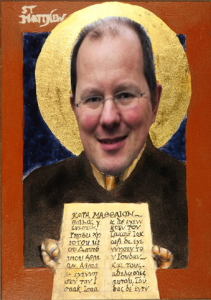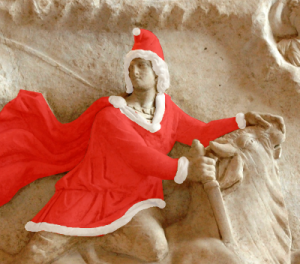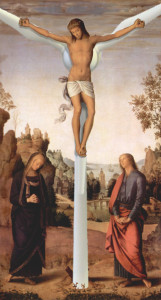It’s traditional at this time to write some pointless diatribe about crucifixion, why the Xes shouldn’t be in Xmas, 666, the Holy grail and much more, so I thought I would join in and try my luck.
And as Jesus happens to be one of my heroes, it’s perhaps time I spoke up for the poor sod who faced the same kind of hanging, drawing and quartering we sceptics were being threatened with not so long ago. But this Jesus is the real historical bloke, not some fake climastrology figure or religious icon.
Unfortunately, we don’t know much about the real Jesus except that he came to prominence in the early years of the first century AD 🙂
There is quite a lot of rubbish written about Jesus by those setting out to disprove his existence and one of the more imaginative ones is that Christ was Mithras.
Was Christ Mithras?
Having read much of the (sensible) new testaments in Greek I’ve little doubt the nativity story was a bolt on addition, probably based on the story of Mithras who likewise:
- was miraculously conceived.
- was a divine incarnations
- was of royal descent.
- Devatas or angels sang songs of praise at the birth
- was visited by neighbouring shepherds.
- the reigning monarch, fearing that he would be supplanted in his kingdom by the divine child, sought to destroy him.
- was saved by friends who fled with them in the night to distant countries.
- foiled in their attempts to discover the babes both kings issued decrees that all the infants should be put to death.
But just because part of the bible is fake, not all of it is.
The mid-winter festival
True, the nativity story is probably a retelling of the nativity story of Mithras and more than likely that is also a retelling of another older story. If the nativity story celebrates anything it is nativity & motherhood itself and the mid-winter festival. Because the 25th was not an arbitrary date. It is instead the date of the mid-winter solstice on the early Roman calendar but it had slipped a few days so that by the time the calendar was fixed – as it happens the pattern of leap years starts at 1AD.
And therefore BC is Before Calendar.
So, what can be trusted in the bible historically?
One of the very big questions concerning Jesus, when there are huge portions of his life that are clearly made up, is how much can be trusted and what is it?
I’d like to say that there is some magic wand that would bring back an independent account of his life, but unfortunately apart from a few sentences in Tacitus (Roman) and Josephus (Jewish splitter) we have next to nothing written by independent historians.
So, the available evidence comes from the various books of the new testament and some other books like the Book of Thomas that the church either felt were too honest, or too dishonest to be included in what came to be known as “the Bible”.
However, ignoring John (who writes like he’s on drugs and provides little historical insight) we have Mark, Matthew and Luke. Mark is a simple script written in Greek and almost all of it is either in Matthew and Luke. Because academics have this idea that simple must mean early, they assume this means it was written first. However, they are likely mistaken. Because the greatest divergence in ideas and language or “disharmony” (and least when read “between the lines” with the later views of the church occur in Matthew. So Matthew is the least establishment & “jewish”, therefore most likely to be earliest although it has clearly been “cleaned up” in great part.
So, what happened?
The languages of Palestine
At the time of Jesus, a lot of the followers wrote the then equivalent of emails & facebook/blogs. These were short articles or anecdotes probably recounting events one person had seen and heard to a friend who could not be there.
At this time Palestine (as the Romans called it) was a land of various languages. It had been part of the Hellenic empire for a while, and Greek was so ubiquitous in the Mediterranean that even most educated Romans spoke it. So this is why most people in Palestine spoke Greek. But some must have clung onto the old ways and spoke Aramaic because parts of the new testament is clearly written in Aramaic. And Hebrew did not die, by the time of Jesus it appears to be reserved for religious purpose in the Temple – but there were zealots who were trying to revive it.
However, along with the Greek language had come new religious ideas. The previous focus of the single temple in Jerusalem was being challenged by a new Greek idea known as the “Synagogue” – the Greek word for Gathering. So, the Hebrew centralist religion was being replaced by a Greek speaking groups who called their new places of worship “assemblies”. This shows that those founding modern Judaism based on synagogue were Greek speakers opposing the Hebrew speaking temple-based religion in Jerusalem – something modern Jews are not keen to hear.
And like the Greek Synagogue, we see other Greek ideas in the New Testament such as the Greek underworld or “Hades” which is not something found in the Old Testament. This time was a melting pot of ideas and languages when the prevailing Greek-speaking population were bringing in new political and religious ideas, that added to and challenged an old established theocracy & state centred around the temple at Jerusalem.
With this mix of languages, it is very likely the first accounts of Jesus were also a mix. Greek being the dominant language (the old testament had to be translated into Greek) was likely used for many accounts. But the religious zeal in Palestine had also created a backlash against Greek and so Aramaic and even Hebrew were being used and/or revived. Some of the letters may even have been in Latin or other local languages.
 The origin of the different books of the New Testament
The origin of the different books of the New Testament
Matthew was a tax collector, a bit like Andrew Montford the accountant of Bishop Hill Blog. Accountants like Andrew like order and tax collectors like collecting. It appears Matthew, being a fan of Jesus, started collecting the various accounts together and trying to make order of them.
He clearly failed in parts as he kept multiple accounts of the same event. So, for example, we have two different versions of the sharing of the loaves and fishes, one now known as the “The Feeding of the 5,000” with five loaves and two fish (Matthew 14:13-21, Mark 6:31-44, Luke 9:10-17 and John 6:5-15.) the other account called “The Feeding of the 4,000” with 7 loaves of bread in Matthew 15:32-16:10 and Mark 8:1-9 but clearly Luke (& John) considered them to be the same story.
Matthew had his “blog” into which he stuffed many and various stories and letters. Then sometime after Jesus had his appointment on the cross, Matthew must have tidied up his “blog” which was then “reblogged” by others. Then much later the blog was further edited and translated into Greek from which we obtain our earliest version of Matthew (or perhaps not thee are claims of an earlier version).
However, the early version must have been available at the time of Mark. Because Mark was a simple man who does not appear to have known Aramaic. It appears from the text of Mark that he had available a version of Matthew with translation notes. You can tell this, because Mark often uses both Greek meanings of an Aramaic word with a dubious translation. It is like he took someone’s annotated Greek notes on their Aramaic Matthew and formed them into sentences so that where both meanings of a word were noted, he does not see the single Aramaic, but instead the two phrases in Greek.
So Mark, who from his focus, appears to be located in Rome (or thereabouts), seems to have borrowed a version of Matthew with Aramaic texts that had been marked up with notes in Greek. This suggests the text came with someone who spoke Aramaic so likely an early evangelist from Palestine. But Mark was a rough fellow and wrote a rough & ready translation. And as the Church became more establishment, they needed something more prestigious, so later the educated Luke wrote a polished version and using both Matthew and Mark. With the polished version of Luke in Greek, there was no need for the Aramaic version of Matthew and must have fallen out of use and would have been completely lost, except for a later translation in Greek done by an establishment figure who dutifully “forgot” to include some parts that were not helpful to the growing Roman Church. (Later is was translated into Latin, then still later into English)
That explains why some very famous Greek texts in Matthew do not appear in Mark. And by far the best of these Greek original texts must be the beatitudes which are likely almost word for word what Jesus said.
The beatitudes (in phonetic Greek)
makarioi oi ptochoi to pneumati, oti auton estin e basileia ton ouranon.
makarioi oi penthountes, oti autoi paraklethesontai.
makarioi oi praeis, oti autoi kleronomesousin ten gen.
makarioi oi peinontes kai dipsontes ten dikaiosunen, oti autoi chortasthesontai.
makarioi oi eleemones, oti autoi eleethesontai.
makarioi oi katharoi te kardia, oti autoi ton theon opsontai.
makarioi oi eirenopoioi, oti autoi uioi theou klethesontai.
makarioi oi dediogmenoi eneken dikaiosunes, oti auton estin e basileia ton ouranon.
makarioi este otan oneidiswsin umas kai dioxosin kai eiposin pan poneron kath umon pseudomenoi eneken emou.
The beatitudes (translated by the church establishment)
Blessed are the poor in spirit: for theirs is the kingdom of heaven.
Blessed are they that mourn: for they shall be comforted.
Blessed are the meek: for they shall inherit the earth.
Blessed are they that hunger and thirst after righteousness
But that’s not the real translation!
Bearing in mind that the brutal Roman regime that ruled Palestine had spies everywhere and would punish anyone openly condemning the Roman puppet state by nailing them to trees and stakes. And on these stakes one would slowly suffocate as breathing became more and more difficult. Hanging by the hands slowly pulls the ribs so as to constrict the lungs. This breathing is only possible by “pulling up” on the nails through the hands, and pushing up on those through the ankles. All this pain, just to get one more breath to stay alive for just a few seconds more, before the next excruciating pull up to struggle to get another breath.
If we imagine 6 breaths a minute. That’s 360 “pullups” an hour. That’s 3600 “pullups” in ten hours. If you were fit, some people could last for days – but Jewish law forbade that, so that is why they broke their legs. Once you couldn’t push up on the legs, death would quickly follow.
The real “blessings”
The real translation of these “blessings” is more sober as it more akin to this:
Happy are those struggling for breath because they will see heaven
Happy are those who mourn ..
Happy are the down trodden for they get the dirt …
Happy are those who seek justice …
I’m sure those pulling in agony on torn limbs to grab one last breath were very happy!
I’m sure those who mourn their death are happy.
The downtrodden are happy, so are the repressed …
Jesus knew just how far he could go condemn the repressive Royal Society of his day without suffering their wrath – or at least he thought he did.
So who was Jesus?
Jesus was a revolutionary and the revolution he wanted was “the kingdom of god”.
“Is that it?” you might ask.
But this was not some airy fairy kingdom in the clouds, but a real Kingdom of God on earth. Unfortunately, these phrases Kingdom of Heaven, Heaven on Earth, etc. are so well known that people have stopped hearing what is actually being said.
When I say “on earth” I mean in the real world. It was “god’s government” not because it was full of mystical beings, but because it was government filled by real flesh and blood people of god.
Heaven was Greek for “sky” and it represented what is holy. It was contrasted with Earth which was that which was of man, that which “belongs to Caesar”. This Kingdom of heaven or God’s kingdom is a contrast with the Kingdom of earth or Caesar’s Kingdom. These were names to hide Jesus’ real political meaning.
Jesus was a politician, yes a politician who wanted a religious state, but what he really aspired to is the same as every nationalist from Ghandi to Alex Salmond: independence from the evil empire!
Jesus wanted the return to the same idyllic notion of nationhood drawn from what the same romantic belief and distorted history of all nationalists that the “grass was always greener before”. He believed in the ancient system of Hebrew theocracy but one updated with concepts from Greek politics and philosophy like Skepticism.
His kingdom of god was a very earthly government, a call for revolution hidden, as he hoped behind a vale of Double Entendre, but netherless clearly stated as a Godly Government much akin to the Vatican or the Dali Lama (before China ousted that theocracy).
But it was God’s chosen people …
I’ve said enough. I could go on and on and on, but I will stop there. Perhaps one day I’ll write a book about concrete and holy grails, but for now, I will conclude by saying that Jesus the man was one of the great orators of history, a real revolutionary, a leader of men and women and a Greek Skeptic.
Happy Xmas
And to all those Greenies out there worshipping “Christmas”, just one last thought. Christ, Greek χριστός (hence the X), means covered in oil, or anointed. χρῖσται “oil, oil flask” from χρίω “to smear, anoint, rub or daub with oil or grease”. So, you are almost literally celebrating oil!




Pingback: When Science fails: the last refuge of a false science – turn Climate Alarmism into religious doctrine | Scottish Sceptic